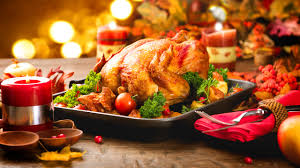Food Safety During the Holidays
go.ncsu.edu/readext?971979
en Español / em Português
El inglés es el idioma de control de esta página. En la medida en que haya algún conflicto entre la traducción al inglés y la traducción, el inglés prevalece.
Al hacer clic en el enlace de traducción se activa un servicio de traducción gratuito para convertir la página al español. Al igual que con cualquier traducción por Internet, la conversión no es sensible al contexto y puede que no traduzca el texto en su significado original. NC State Extension no garantiza la exactitud del texto traducido. Por favor, tenga en cuenta que algunas aplicaciones y/o servicios pueden no funcionar como se espera cuando se traducen.
Português
Inglês é o idioma de controle desta página. Na medida que haja algum conflito entre o texto original em Inglês e a tradução, o Inglês prevalece.
Ao clicar no link de tradução, um serviço gratuito de tradução será ativado para converter a página para o Português. Como em qualquer tradução pela internet, a conversão não é sensivel ao contexto e pode não ocorrer a tradução para o significado orginal. O serviço de Extensão da Carolina do Norte (NC State Extension) não garante a exatidão do texto traduzido. Por favor, observe que algumas funções ou serviços podem não funcionar como esperado após a tradução.
English
English is the controlling language of this page. To the extent there is any conflict between the English text and the translation, English controls.
Clicking on the translation link activates a free translation service to convert the page to Spanish. As with any Internet translation, the conversion is not context-sensitive and may not translate the text to its original meaning. NC State Extension does not guarantee the accuracy of the translated text. Please note that some applications and/or services may not function as expected when translated.
Collapse ▲
golden brown turkey on a black platter, garnished with greens, tomatoes, vegetables, sitting on a dining table with red dishes, holiday lights in the background
‘Tis the season for spending time with families and loved ones. Do you ever think of how many holiday gatherings center around food? Each holiday gathering brings together those we care about most by sharing a meal or other foods. Most of us never think about the potential of food to make us sick and diminish our holiday traditions. During the holidays, we are so caught up with the festivities, presents, church events, visiting with family and friends, parties and gatherings, the excitement of the season, and our daily activities that we tend to forget or focus on food safety. Even though I do not want to dampen your holiday spirit, there are 9.4 million episodes of foodborne illnesses each year in the United States. Out of the 9.4 million episodes, there are 55,961 hospitalizations and 1,351 deaths from foodborne illnesses. The top pathogens that cause foodborne illnesses in the United States are norovirus, non typhoidal Salmonella, C. perfringens, and Campylobacter. Food typically becomes contaminated from agents such as bacteria, viruses, parasites, chemicals, or transmission from nonfood items like animals or contaminated water. In the home, the majority of foodborne illnesses are the result of improper cooling, advance preparation, an infected person, inadequate heating for hot holding, improper hot holding methods, contaminated raw food or ingredients, unsafe food sources, or the use of leftovers. Those who are especially susceptible to the symptoms of foodborne illnesses are the young (under 5 years old), the old (over 65 years old), pregnant women, or people who are immunocompromised. In an effort to keep us all safe and prevent our loved ones from becoming sick, the CDC has useful guidelines to follow to help prevent foodborne illness from happening in our homes.
When preparing those fabulous foods and treats this holiday season, remember to follow these safety guidelines:
-
-
- Keep foods separated.
- Keep meat, chicken, turkey, seafood, and eggs separate from all other foods at the grocery store and in the refrigerator.
- Prevent juices from meat, chicken, turkey, and seafood from dripping or leaking onto other foods by keeping them in containers or sealed plastic bags.
- Store eggs in their original carton in the main compartment of the refrigerator.
- Cook food thoroughly.
- Use a food thermometer to make sure meat, chicken, turkey, seafood, and eggs have been cooked to a safe internal temperature to kill germs.
- Roasts, chops, steaks, and fresh ham should rest for 3 minutes after you remove them from the oven or grill.
- Keep food out of the “danger zone.”
- Germs grow rapidly in the danger zone between 40°F and 140°F.
- After food is prepared, keep hot food hot and cold food cold.
- Refrigerate or freeze perishable food like meat, chicken, turkey, seafood, eggs, cut fruit, cooked rice, and leftovers within 2 hours (1 hour if food is exposed to temperatures above 90°F, such as in a hot car).
- Keep the temperature in your refrigerator set at 40°F or below and the freezer at 0°F or below.
- Use pasteurized eggs for dishes containing raw eggs.
- Salmonella and other harmful germs can live on both the outside and inside of normal-looking eggs.
- Many holiday favorites contain raw eggs, including eggnog, tiramisu, hollandaise sauce, and salad dressings.
- Always use pasteurized eggs when making these and other foods made with raw eggs.
- Know that raw flour and eggs can have germs.
- Uncooked dough and batter made with flour or eggs can contain harmful germs, such as E. coli and Salmonella. This includes dough or batter for cookies, cakes, pies, biscuits, pancakes, tortillas, pizza, or crafts. Some companies and stores offer edible cookie dough made with heat-treated flour and pasteurized eggs or no eggs. Read the label carefully to make sure the dough is meant to be eaten without baking or cooking.
- Thaw your turkey safely.
- Thaw frozen turkey in the refrigerator, in a sink of cold water (change the water every 30 minutes), or in the microwave.
- Do not thaw turkey or other foods on the counter. A turkey must thaw at a safe temperature to prevent harmful germs from growing rapidly. Learn more about preparing turkey safely.
- Wash your hands with soap and water during these key times when you are likely to get and spread germs:
- Before, during, and after preparing food
- Before eating food
- After feeding pets
- After using the toilet
- After changing diapers or cleaning up a child who has used the toilet
- After touching garbage
- Before and after caring for someone who is sick
- Before and after treating a cut or wound
- After blowing your nose, coughing, or sneezing
- Keep foods separated.
-
By following the guidelines from the CDC, your family and loved ones should stay safe over the holidays.




